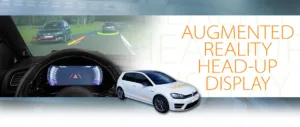Visteon Corporation – a technology leader in automotive cockpit electronics – is launching its latest advancements in windshield head-up display (HUD) technology, including an innovative augmented reality (AR) driving solution that combines a view of the vehicle’s road ahead with audio, light and video to create a multi-modal experience designed to enhance the driver’s situational awareness.
Visteon’s AR system overlays graphics in the driver’s line of sight to represent objects in the vehicle’s path, provides navigation guidance; and displays relevant information, such as lane departure warning.
In addition to delivering the benefits of AR, the concept incorporates Visteon’s windshield HUD with a wide-field image, which – at 10°x4° – is about twice the size of a standard windshield HUD and allows the driver to see additional information not usually displayed in HUD systems.
The concept is based on a sensor-driven approach that applies advanced data processing and sensor fusion technologies to ensure the vehicle recognizes its precise positioning and what is happening within its immediate surroundings. It goes beyond conventional windshield HUD technology by projecting recommended – or automated – courses of action on the windshield as part of a real-time driving experience.
“AR plays a critical role in building driver confidence in assisted driving situations such as collision avoidance and brake assist,” said Remi Sigrist, engineering manager in Visteon’s Technology Office. “AR can translate alerts into a visually rich representation of the vehicle’s environment and display information exactly where the driver needs it – in their direct view through the windscreen – to respond quickly when changing between assisted and driver-driven mode.”
The system’s embedded front-view and driver monitoring cameras trigger “smart alerts” in the form of lights and sounds when the driver is not paying attention to the road, if the vehicle strays from its lane, or if the vehicle is at risk of potentially hitting an object. For example, when a pedestrian or bicycle is present on the side of the road, a LED light projects onto the windshield within a 80° angle of the driver’s line of sight, giving a visual alert without the driver needing to turn their head.
In parallel, Visteon is also developing advanced dual-image windshield HUD technology combining two virtual images. The first image is projected 15 meters in front of the vehicle and overlaid on the road as an AR feature while the second virtual image is projected two meters from the driver’s line of sight. The two independent images are separated by a semi-transparent mirror and fully overlap in the driver’s view.
Designed to help keep the driver’s attention on the road, HUD applications are gaining popularity as a preferred interface for vital information, such as vehicle speed and warning messages, to be displayed as a virtual image directly in the driver’s field of vision. Affordable technology solutions, the adoption of advanced driver assistance systems (ADAS), and consumer demand for safety are bringing HUD applications into mass-market vehicles at an annual growth rate approaching 30 percent. Visteon has delivered more than 1 million HUD units for production vehicles.

